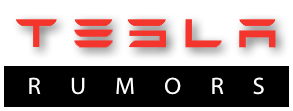Tesla Model X: What to Expect on Feb 9, 2012

Friday, Jan 13, 2012 by Max Mindel
(Updated on Jan 31, 2012)

Tesla Model X: What to Expect on February 9, 2012
The countdown has begun. By February 9th, at 8:00pm, Tesla Motors will reveal to the world, the new Model X. The Model X is Tesla’s upcoming crossover vehicle. Many may be pondering, why a crossover (CUV), and not an SUV? This is because most people who are driving a crossover vehicle are unaware of it because they have no notion of the differences. I myself am guilty of that. I’ve referred to My Lexus RX as an SUV (although it’s a CUV), since the day I bought it. Many vehicles which people call SUVs are in reality CUVs. Among these are the BMW X5, Acura MDX (RDX & ZDX too), Mazda CX, Nissan Murano, Porsche Cayenne, Toyota RAV4, Volvo XC and more.
So now that we’re all really confused, what’s the difference? An SUV is a car similar to a station wagon that is built on a light-truck chassis, sometimes offering the towing ability of pickup truck, and in some cases some off-road capability. The early versions of the Ford Explorer were true SUVs. SUVs today are actually rare. Poor fuel efficiency killed them off slowly and they were gradually replaced by the Crossover.
The biggest difference between an SUV and a CUV is that a CUV is built on a car chassis, often referred to as a unibody. So it’s a vehicle built on a car platform which borrows features from a traditional SUV mixed with features from a passenger vehicle; especially like those found in a station wagon or hatchback vehicle. This may be somewhat confusing, especially since Tesla Motor’s upcoming sedan, the Model S, is also a hatchback vehicle. The Model X, if it truly is a crossover vehicle, may offer the following:

This refers to where your hip pivot point is relative to your feet. In a sports car, like the Tesla Roadster, your hip is pretty low because you are sitting relatively low, and your legs are extended more. High H-point seating found in minivans, SUVs, CUVs, trucks and buses offers easier exit and entry from a vehicle, more comfort, and often more leg room.

Ground clearance in a vehicle refers to the amount of space between the base of the tire and the bottom of the vehicle chassis. Higher ground clearance creates a higher center of gravity which reduces handling but makes the vehicle more capable of navigating roads that are uneven and thus reduces the potential of scraping the bottom of the car. Aerodynamics too is reduced as a car’s ground clearance is increased. The Model X, since it borrows the chassis from the Model S, will still have a lower center of gravity that any other CUV due to its battery weight at the bottom of the vehicle.

A liftgate which is often referred to as a hatch, hatchback or liftback is a closure at the rear of a vehicle that can be raised or lowered for loading and unloading. The Tesla Model S has hatchback or liftgate style trunk lid too. This is typically a lid that you lift upwards to provide access to your CUV through the rear of the vehicle.


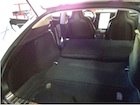
In a crossover vehicle and in an SUV, seats typically fold down and/or are removable. This offers the flexibility in configuring your vehicle’s cabin space to whatever your need might be on any particular day. Ironically, the Tesla Model S, which is a sedan, offers some of these features in which the seats while not removable, do in fact fold down to provide ample cargo space when needed.
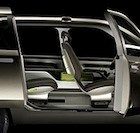
Crossovers typically have more headroom, and this is largely due to the way in which the interior is designed to provide height for high H-point seating. You can expect to find about 8 more inches of height in a CUV than you can in a sedan. This provides passengers with an easier ability to move around the vehicle to go from one seat to another which is particularly important when you have a 3rd row of front-facing seats in the back.
So what do we know? We know that the Model X will be designed on the Model S chassis. We also know that it is a crossover vehicle. We know this from video footage of Elon Musk, Tesla Motors’ CEO, in which he has made these specific statements. Also, in Tesla Motors’ November 2011 8-K filing with the US Securities and Exchange Commission, they write “Our vision for the Model X is a vehicle that combines the functionality of a minivan with a design as cool as an SUV. So perhaps, it may be more about passenger space than about cargo. However, thanks to an investment publication by Barclay, we have additional information. Apparently people at Barclay got to preview the Model X. They have been quoted publishing “Tesla Model X SUV is a premium product for premium customers. Faster than 911, roomier than Audi Q7.” So we can expect it to be a luxurious, roomy, and fast vehicle. So how roomy is an Audi Q7? The photo below may give you a sense of that.
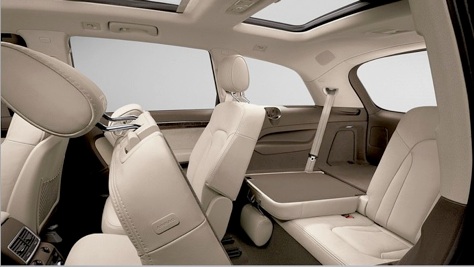
Thanks to the invitation that was sent out to invited guests, we see a partial silhouette of the Model X. From this very dimly lit photograph, you can only see a partial front and and roofline. It appears to be as sleek as the Model S. But from this invitation we can only speculate what the rest of the car looks like. On January 27th, Elon Musk tweeted, ”Most cars are pretty blah. This is not.”
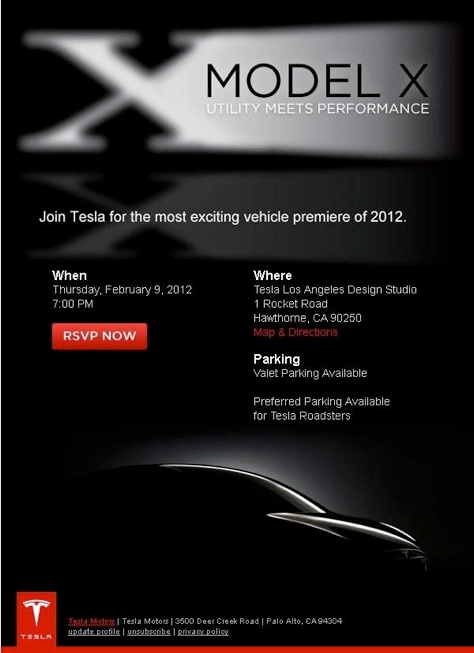
The Model X has a planned release timeframe of end of year 2013. If you’re like me, and you think you may consider switching from a Model S to a Model X after it’s design is revealed, you may be faced with a longer wait time than the end of 2013 if you’re not opting for a Signature version or a larger battery capacity, so you’re wait time could be pushed well into 2014. Also, since the Model X is likely to weigh more than the Model S due to its size, it will be interesting to see by how much it’s rated distance for travel is reduced. It’s possible that the Model X may be offered with only the 2 larger 60kwh and 85kwh batteries that are offered in the Model S, and skip the 40kwh battery that offers 160 miles of range in the Model S. Perhaps we’ll see 3 battery choices that are of a completely different KWH size that still offer the same 160, 230, and 300 ranges. I know all of these issues may sway my decision one way or another.
For whatever else we want to know, we’ll have to wait. But one thing we can all agree on, is that like the Roadster and the Model S, the Model X is likely to offer style that will make it the Crossover electric vehicle that everyone wants. So I’ll see you back here on the late evening of February 9th, when I’ll share my thoughts and observations about the Model X when it is revealed to the world.
Until then, keep on imagining!



The Tesla Model X Countdown has begun.
HAVE COMMENTS OR QUESTIONS? WE LOOK FORWARD TO HEARING FROM YOU.
Index to News Articles
Feb 08, 2012 - EVs are the Future: Believe the Hype!
Jan 23, 2012 - Cell Phones and Cars in an Alternate Universe
Jan 15, 2012 - Model X: What to Expect on Feb 9, 2012
Jan 08, 2012 - Model S Signature Cars Sold Out in the USA!
Jan 05, 2012 - New Car Value Index Reveals Best Deals
Dec 21, 2011 - The Signature Model S has a $3,550 Premium
Dec 20, 2011 - Model S Options & Pricing Observations
Dec 10, 2011 - Model S Options may be disclosed on Dec 15?
Nov 28, 2011 - Tesla Reinvents the Car Buying Experience

Copyright © 2012 TeslaRumors.com All rights reserved.


EVs are the Future: Believe the Hype
Tesla Model X: What to Expect on Feb 9, 2012
The Signature Model S is now Sold Out!
New Car Value Index Reveals Best Deals
The Signature Model S has a $3,550 Premium
Model S Options and Pricing Observations
Modei S Options may be disclosed on Dec 15
Tesla Reinvents the Car Buying Experience
Did I realy just buy a car online?







TeslaRumors.com is not affiliated with Tesla Motors, Inc.
The Tesla Motors logo is a registered trademark of Tesla Motors, Inc.
All other trademarks are the property of their respective owners.
TM
VISITORS



